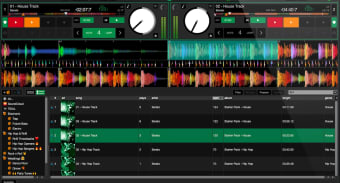

This works especially well between tracks that, once again, vary widely in BPM, because beatmatching while changing tempo could sound very off depending on the track (see our techniques for tempo changes here).
#Record serato dj intro software#
This technique involves using DJ software or mixer’s FX to create a nice transition between tracks. Just use the faders to bring in the incoming track, and once it is up, bring down the volume of the outgoing track before it kicks back in with any percussion or beat. The tracks are in the same key so it sounds pleasing when transitioning. This is a great way to engage your crowd, as often the lack of percussion can leave a bit of a break in the dancing, and you don’t want that for too long.

You can see the vocals come in around when I start to mix out the first track, which gains the audience’s attention right away. In the above example, I used two tracks of widely varying BPMs, one at 99 and one at 60 (120). This technique can be paired with FX as well (see the next tip). This trick shines when you have tracks that don’t beatmatch well together, or vary vastly in BPM. If done right, the audience can’t hear a deliberate fadeout. The idea is to pick to parts that have more melodic content, without drums and percussion, and blending them together to create a ‘wash’ of sound. If done correctly, it can sound very natural and professional. This technique is a gradual fade between two tracks that have similar phrasing. The tracks in the video example above are similar BPMs, and I brought the second track in right when the beat comes in, so it sounds seamless. This particular trick works well on tracks with a well-defined beat, and genres that are a bit heavier like dubstep or trap (where long blending could sound quite messy when you’re trying to keep it high energy).

Let the outgoing track build up to a phrase change ( learn more about the importance of phrasing here).Snapping into a major phrase change – like the start of a breakdown or into a drop – can work wonders. Slowly fade the bass out in the other track, and release the loop just as the other track ends. Simply have the fader down on the second track, and slowly bring it in, adjusting the EQ and slowly bringing the bass in. If the first track was shorter, I could have used two loops, one on each track. In the video example below, I used a 16 bar loop to bring in that piano/clap into but extended it as I was fading out the other track, which had more of a longer outro. Using loops of 4-16 beats usually work best for these kinds of songs. Release the loop just as the old song is mixed out so it comes straight into a main part of the track.The key here is to loop the track at a part that doesn’t sound abrupt and doesn’t cut off any key material, so usually a drum loop or percussion part works best.
#Record serato dj intro full#

It’s not uncommon for tracks to have short intros and outros – this has been the case in other genres (like hip-hop) for years, and for DJs who play more commercial tracks in the realms of pop music the situation is similar. Not every producer is making music with DJ sets in mind. In today’s article, guest contributor Aden Russel shares four common DJ mixing techniques that can be used to tackle these more challenging tracks. When you’re playing a set and selecting from tunes that aren’t designed with DJs in mind, mixing can be challenging.


 0 kommentar(er)
0 kommentar(er)
